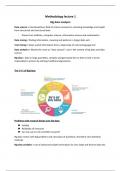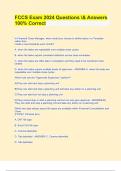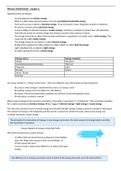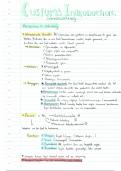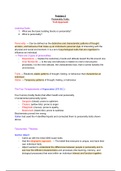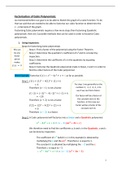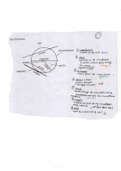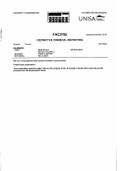Chapter 18: Production of goods and services
Production: The provision of a product or service in order to satisfy customer wants/needs. It adds value to the raw
materials and the process applies to manufacturing and service industries.
Inputs used to produce more valuable outputs: Land, Labour, Capital, and Enterprise.
- They need to be combined efficiently
Developing countries – labour intensive because lower wages.
Developed countries – Capital intensive because labour costs are high.
Operations Department: Take inputs and make into outputs for customers. In manufacturing businesses, it contains
factory and purchasing managers but in service it has general managers.
FORMULAS If employees are more efficient, then
output produced per worker rises so
Productivity = Output / Input
the cost of producing each product will
Labour Productivity = Output / No. of employees fall. This makes business more
competitive and is main reason for
Labour cost per product = Labour cost / average
increasing productivity.
productivity
Increase Productivity by: Automation, Training, and Motivation
Benefits of Increasing Productivity: Lower average cost, Fewer workers, Lower cost = lower price
Inventories contain raw materials, components, partly finished products and finished products.
- Holding inventories allows business to maintain production and satisfy customer demand quickly.
Buffer inventory: level of inventory held to deal with Lean Production: techniques used by
uncertainty in customer demand and deliveries of businesses for cutting waste (time,
supplies. transport, inventory, and defects),
increasing efficiency, lower costs.
Costs lowered: less storage, quicker
production, no repairing defects, and
less money tied up in inventories.
Lower costs lower prices
Lower process more competitive
Competition Profit
Forms of lean production:
- Kaizen: ‘continuous improvement’ through elimination of waste. Improvement comes from workers who
meet to discuss problems and solutions on how to be more productive.
- JIT inventory control: Reduces/ eliminates inventories. Raw materials are delivered just in time for the
production process which finishes just in time to be delivered to consumers. This reduces inventory costs
and warehouses not needed.
- Cell production: production line divided into cells each making part of the finished product.
, Methods of Production:
- Job production: products made specific to order.
(+) meet exact requirements and workers have varied jobs.
(-) skilled labour, costs are high (labour intensive), and takes a long time.
- Batch production: similar products are made in batches e.g., small bakery.
(+) variety
(-) movement between production stages
- Flow production: standardised product made in continuous process in large amounts.
(+) high output and low average cost
(-) initial capital cost
Factors affecting which method to use: Technology
- Nature of the product (unique?)
- Size of market Advantages: Productivity increases as
- Nature of demand (high demand? low demand?) more efficient production methods
- Size of business are used, better quality, and new
high-tech products introduced
New technology: allowed more automation of production methods. keeping ahead of competition.
- Automation: equipment controlled by computer Disadvantages: unemployment could
- Mechanisation: equipment operated by workers rise and expensive to invest initially.
- CAD: software draws items being designed
- CAM: computer monitors production and controls machines.
- CIM: integration of CAD and CAM
Technology in shops:
- EPOS: operator scans barcode at checkout
- EFTPOS: electronic funds transfer at point of sale
- Contactless payment
Chapter 19: Costs, Scale of production and Break-even analysis
Costs are needed for:
- Calculating whether business will make profit or a loss
- Deciding price of a product (over the average cost)
- Location decisions
Fixed costs: they do not vary in the short term with the items sold or produced. Overhead costs.
Variable costs: vary directly with the amount produced and sold.
Total cost: fixed + variable costs.
o Average cost per unit = total costs of production / total output
o Total cost =average cost per unit x output
o Average fixed cost = fixed cost / output
Economies of Scale: factors which lead to a reduction in average cost as a business increases size.
- Purchasing: bulk discounts
- Marketing: cost of marketing is absorbed by the higher output
- Financial: loans and lower interest rates
- Managerial: specialists
- Technical: specialist machinery
Diseconomies of Scale: factors that lead to an increase in average cost as a business grows beyond a certain size.
- Poor communication: more difficult to send/receive messages
- Lack of commitment: workers feel unimportant and are less efficient
Production: The provision of a product or service in order to satisfy customer wants/needs. It adds value to the raw
materials and the process applies to manufacturing and service industries.
Inputs used to produce more valuable outputs: Land, Labour, Capital, and Enterprise.
- They need to be combined efficiently
Developing countries – labour intensive because lower wages.
Developed countries – Capital intensive because labour costs are high.
Operations Department: Take inputs and make into outputs for customers. In manufacturing businesses, it contains
factory and purchasing managers but in service it has general managers.
FORMULAS If employees are more efficient, then
output produced per worker rises so
Productivity = Output / Input
the cost of producing each product will
Labour Productivity = Output / No. of employees fall. This makes business more
competitive and is main reason for
Labour cost per product = Labour cost / average
increasing productivity.
productivity
Increase Productivity by: Automation, Training, and Motivation
Benefits of Increasing Productivity: Lower average cost, Fewer workers, Lower cost = lower price
Inventories contain raw materials, components, partly finished products and finished products.
- Holding inventories allows business to maintain production and satisfy customer demand quickly.
Buffer inventory: level of inventory held to deal with Lean Production: techniques used by
uncertainty in customer demand and deliveries of businesses for cutting waste (time,
supplies. transport, inventory, and defects),
increasing efficiency, lower costs.
Costs lowered: less storage, quicker
production, no repairing defects, and
less money tied up in inventories.
Lower costs lower prices
Lower process more competitive
Competition Profit
Forms of lean production:
- Kaizen: ‘continuous improvement’ through elimination of waste. Improvement comes from workers who
meet to discuss problems and solutions on how to be more productive.
- JIT inventory control: Reduces/ eliminates inventories. Raw materials are delivered just in time for the
production process which finishes just in time to be delivered to consumers. This reduces inventory costs
and warehouses not needed.
- Cell production: production line divided into cells each making part of the finished product.
, Methods of Production:
- Job production: products made specific to order.
(+) meet exact requirements and workers have varied jobs.
(-) skilled labour, costs are high (labour intensive), and takes a long time.
- Batch production: similar products are made in batches e.g., small bakery.
(+) variety
(-) movement between production stages
- Flow production: standardised product made in continuous process in large amounts.
(+) high output and low average cost
(-) initial capital cost
Factors affecting which method to use: Technology
- Nature of the product (unique?)
- Size of market Advantages: Productivity increases as
- Nature of demand (high demand? low demand?) more efficient production methods
- Size of business are used, better quality, and new
high-tech products introduced
New technology: allowed more automation of production methods. keeping ahead of competition.
- Automation: equipment controlled by computer Disadvantages: unemployment could
- Mechanisation: equipment operated by workers rise and expensive to invest initially.
- CAD: software draws items being designed
- CAM: computer monitors production and controls machines.
- CIM: integration of CAD and CAM
Technology in shops:
- EPOS: operator scans barcode at checkout
- EFTPOS: electronic funds transfer at point of sale
- Contactless payment
Chapter 19: Costs, Scale of production and Break-even analysis
Costs are needed for:
- Calculating whether business will make profit or a loss
- Deciding price of a product (over the average cost)
- Location decisions
Fixed costs: they do not vary in the short term with the items sold or produced. Overhead costs.
Variable costs: vary directly with the amount produced and sold.
Total cost: fixed + variable costs.
o Average cost per unit = total costs of production / total output
o Total cost =average cost per unit x output
o Average fixed cost = fixed cost / output
Economies of Scale: factors which lead to a reduction in average cost as a business increases size.
- Purchasing: bulk discounts
- Marketing: cost of marketing is absorbed by the higher output
- Financial: loans and lower interest rates
- Managerial: specialists
- Technical: specialist machinery
Diseconomies of Scale: factors that lead to an increase in average cost as a business grows beyond a certain size.
- Poor communication: more difficult to send/receive messages
- Lack of commitment: workers feel unimportant and are less efficient

